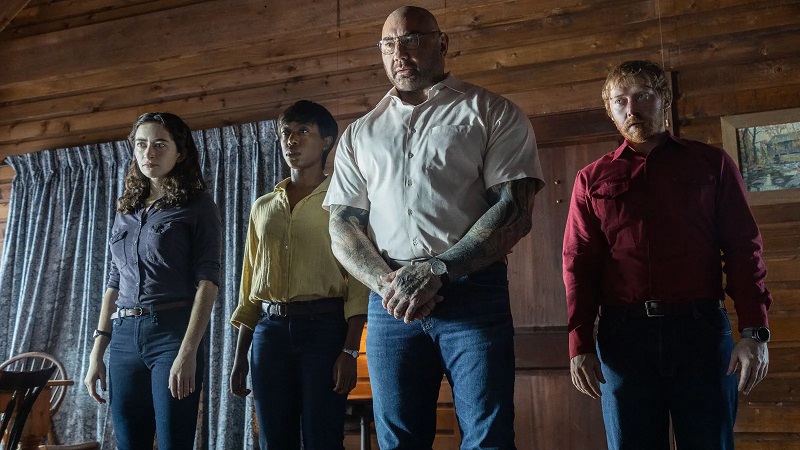Knock at the Cabin (Shyamalan, 2023)
Knock at the Cabin (2023) is a quintessential M. Night Shyamalan movie but with a biblical twist. It has a dramatic plot, an A-list anchor, and (SPOILER ALERT) a gratuitous cameo by the man himself. It’s a dyed-in-the-wool formula that M. Night Shyamalan has successfully employed for 30 years.
With that being said, his overall body of work is a bit confounding. He has blessed us with movies like The Sixth Sense (1999), Unbreakable (2000), and Signs (2002). But has also insulted us with abominations like The Village (2004), Lady in the Water (2006), and The Happening (2008). (We’re going let Will Smith take the hit for 2013’s After Earth). The point is, when you go to see an M. Knight Shyamalan movie you have no idea what you’re going to get, and that uncertainty is part of what entices us to go see his movies. And Knock at the Cabin does a good job of teasing that uncertainty with a pretty compelling premise.
Shyamalan bases the premise of Knock at the Cabin on a 2018 novel called The Cabin at the End of the World by Paul G. Tremblay. In that novel, a precocious 7-year-old named Wen and her adoptive parents, Eric and Andrew, take a vacation to a remote cabin on a quiet New Hampshire lake. One afternoon, as Wen is catching grasshoppers in the front yard, a stranger named Leonard unexpectedly comes traipsing out of the woods. He politely introduces himself but makes it clear that he is not making a social visit. Three more strangers descend upon the cabin and the story becomes a frenetic exploration of things like paranoia, sacrifice, and survival. The family must decide which one of them will die for the sake of humanity. (Nobody did it better than Christ, but you guys can give it a shot.) Shyamalan mostly sticks to the book’s script but makes the tale his own with deliberate skill.
And M. Night Shyamalan’s skillful use of cinematography is what makes this movie so good. His use of camera movement and framing in Knock at the Cabin is something to truly appreciate. Throughout the movie, Shyamalan uses Steadicam shots to soothe the audience into an ominous sense of tranquility. The quiet cabin amongst the solitude of the trees and the simplicity of its interior all feel so placid. However, close ups of the actors’ faces constantly dash that peace. Leonard (Dave Bautista) is especially alarming. And it’s not because Leonard is a grotesque monster. (However, Bautista is a hulking man that looks like he could end your life at his discretion—with his bare hands!) It’s because of Bautista’s expert portrayal of quiet menace and Shyamalan’s ability to bring you face-to-face with it.
Shyamalan uses the camera to manipulate your emotions and thoughts in a way that makes the movie feel poignantly interactive. It asks important moral and ethical questions of you through cinematography that brings you face-to-face and heart-to-heart with the movie’s most important characters. Close-ups of Rupert Grint (Redmond) make you wonder what happened to that sweet little boy from Gryffindor! Redmond is a homophobic jerk that Harry Potter would have absolutely nothing to do with! Wen, played by an adorable Kristen Cui, has a cleft lip (a prosthetic for the movie) and her close-ups challenge your ability to look past an aesthetic imperfection and appreciate a person for who they are. The close shots of Eric (Jonathan Goff) and Andrew (Ben Aldridge) help frame nearly impossible choices of life or death and effectively put viewers in the frantic state of consciousness that the circumstances of the situation demand. Shyamalan creates gripping tension throughout the film’s runtime and that makes the movie enthralling.
The movie ultimately grabs you though because you get to watch these people wrestle with a Sophie’s choice that you’re just happy to not be dealing with! At one point in the movie, Eric says, “There is nothing more flawed and perfect in this world than our family.” And that line resonates because we can all empathize with it. When you build a family or find one, no matter what it looks like, it becomes the world to you and the thought of breaking it apart for any reason is unfathomable (unless somebody writes a book or makes a movie about the scenario). Trying to fathom that choice was the crux of The Cabin at the End of the World and one of the best parts of Knock at the Cabin is the way that Shyamalan reimagines Tremblay’s story while maintaining the spirit of it.

